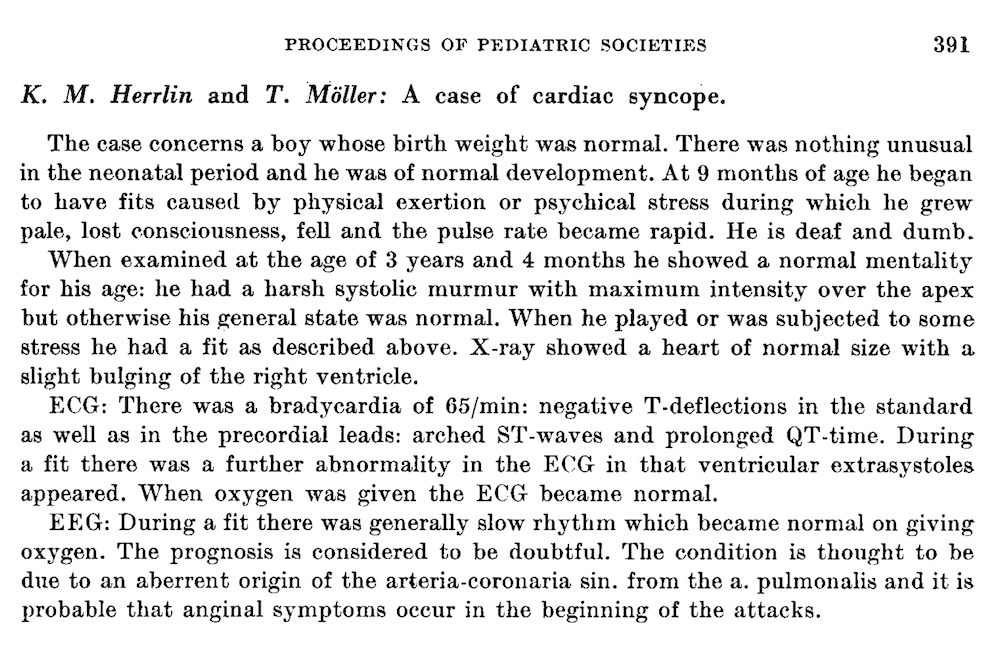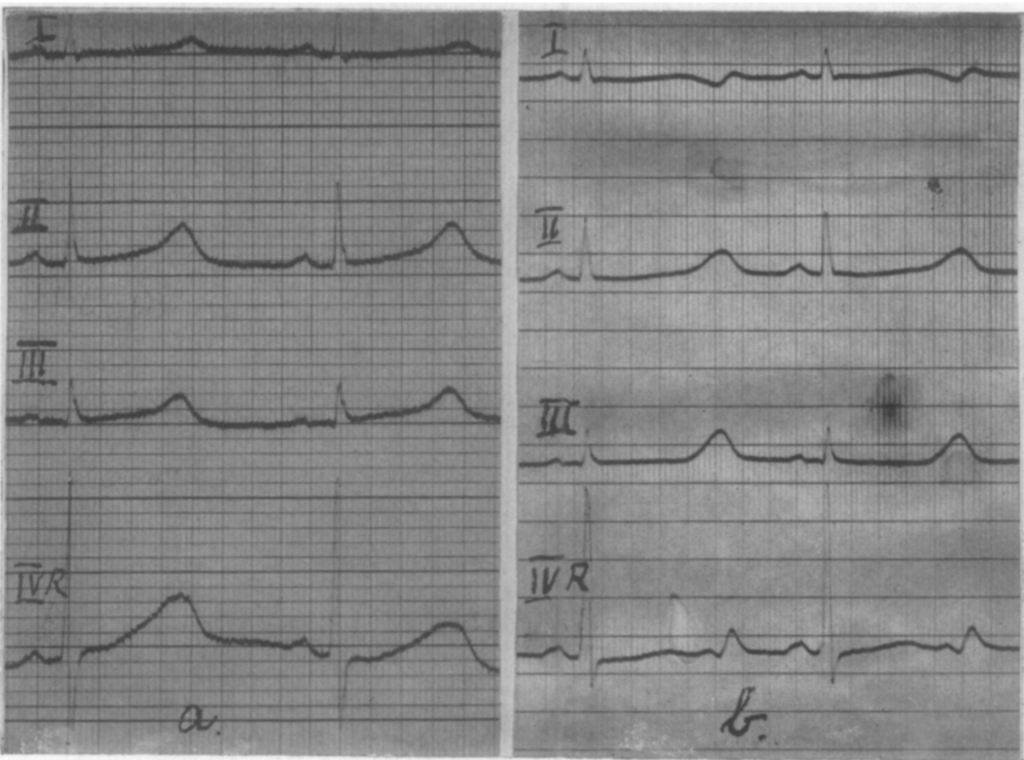Jervell and Lange-Nielsen syndrome
Description
Congenital (autosomal recessive) long QT syndrome (LQTS)
- *Associated with severe, bilateral sensorineural hearing loss.
- Two genetic mutations identified encoding cardiac potassium channels.
- Due to high risk of sudden cardiac death ICD implantation is usually required
Long QT Syndrome History
1856 – Friedrich Ludwig Meissner (1796-1860) a German obstetrician and paediatrician described the sudden death of deaf girl. The young girl collapsed and died while being publicly admonished at school. The parents were not surprised, having lost 2 other ‘deaf-mute’ children under similar circumstances of fright and rage [Meissner, 1856: 119-120]
1901 – Luís Morquio (1867-1935) described a Uruguayan family in which five of eight siblings suffered frequent ‘syncopal’ episodes. Four of these children died. No ECG’s were available and deafness was never mentioned. However, the children were described as apathetic, reserved, unsociable and distrustful: epithets deemed to cloak a degree of undetected hearing loss [Morquio, 1901: 467-475]
1953 – Herrlin and Möller describe a case of recurrent cardiac syncope in a young boy suffering deafness. They record the ECG and note negative T-deflections in all leads; arched ST-waves; and a prolonged QT-time. Herrlin and Möller describe first association between syncope, deafness and LQTS

1957 – Norwegian Professor of Cardiology, Anton Jervell (1901-1987) with his colleague and jazz virtuoso Fred Lange-Nielsen (1919-1989) described an autosomal recessive syndrome of long-QT interval with deafness and sudden death
Four cases of deaf-mutism combined with a peculiar heart disease have been observed in one family. The parents and 2 other children were healthy and had normal hearing. The deaf-mute children all suffered attacks of fainting, probably Adams-Stokes seizures caused by standstill of the heart. The first attack occurred between the ages of 3 and 5 years, and 3 of the children died in such attacks at the ages of 4, 5, and 9 years, respectively.
Electrocardiographic studies in 3 of the cases revealed a marked prolongation of the Q-T interval.
Am Heart J. 1957
Jervell and Lange-Nielson recounted one case of a young boy, born in 1944 suffering from repeated ‘fainting attacks’ since the age of 3. The attacks usually occurred following effort. Occasionally the boy had complained of palpitations and precordial pains. In July, 1953, he was examined with the only pathologic finding being a prolongation of the Q-T interval in the electrocardiogram, worse following exercise. On Nov. 19, 1953, he had a further attack. He suddenly became pale and fell unconscious and died.

(a) ECG July 20. 1953, during rest. Leads I, II, III. IVR. Q-T = 0.50s. R-R = 0.88s.
(b) ECG July 20, 1953. after stair-running. Leads I. II. III, IVR. Q-T = 0.60s R-R = 0.86s. Jervell A, Lange-Nielsen F. 1957
1958 – Samuel Albert Levine (1891-1966) described a similar case involving a young boy who had been observed since 1949 with deaf-mutism, syncopal episodes and sudden death at the age of 13. [Levine, 1958]
1964 – Fraser suggested that heterozygous family members of persons with JLNS may show slight or moderate prolongation of the QT interval
1979 – International Long-QT Syndrome Registry was initiated to collect data on any patient with LQTS
2001 – Advances in research with paper by Schwartz et al: Life-threatening arrhythmias in LQTS patients tend to occur under specific circumstances in a gene-specific manner.
2005 – 25th Anniversary International LQTS Registry collating clinical discoveries from the past 25 years and setting ongoing aims for future research in this challenging field: ‘Our quest for uncovering the secrets of LQTS continues‘ [PMID 15753228]
Associated Persons
- Luís Morquio (1867-1935)
- Anton Jervell (1901- 1987)
- Fred Lange-Nielsen (1919-1989)
- Cesarino Romano (1924-2008)
- Owen Conor Ward (1923-2021)
Alternative names
- Jervell-Lange-Nielsen syndrome (JLNS)
- Autosomal recessive long QT syndrome (LQTS)
- Cardioauditory syndrome
References
Historical articles
- Meissner FL. Taubstummheit und Taubstummenbildung. [Deaf-dumbness and deaf-mute-education] Leipzig and Heidelberg; 1856: 119-120
- Morquio L. Sur une maladie infantile et familiale caractérisée par des modifications permanentes du pouls, des attaques syncopales et épileptiformes et la morte subite. Archives de médecin des enfants. 1901; 4: 467-475
- Herrlin KM, Möller T. A case of cardiac syncope. Acta Pædiatrica, 1953; 42: 391.
- Jervell A, Lange-Nielsen F. Congenital deaf-mutism, functional heart disease with prolongation of the Q-T interval and sudden death. Am Heart J. 1957 Jul;54(1):59-68.
Review articles
- Levine SA, Woodworth CR. Congenital deaf-mutism, prolonged QT interval, syncopal attacks and sudden death. N Engl J Med. 1958 Aug 28;259(9):412-7.
- Fraser GR, Froggatt P, James TN. Congenital deafness associated with electrocardiographic abnormalities. Q J Med. 1964 Jul;33:361-85
- Schwartz PJ. Idiopathic long QT syndrome: progress and questions. Am Heart J. 1985 Feb;109(2):399-411.
- Schwartz PJ et al. Genotype-phenotype correlation in the long-QT syndrome: gene-specific triggers for life-threatening arrhythmias. Circulation. 2001 Jan 2;103(1):89-95
- Farwell D, Gollob MH. Electrical heart disease: Genetic and molecular basis of cardiac arrhythmias in normal structural hearts. Can J Cardiol. 2007 Aug; 23(Suppl A): 16A–22A.
- Moss, AJ, Schwartz PJ. 25th Anniversary of the International Long-QT Syndrome Registry. Circulation. 2005 Mar 8;111(9):1199-201
- Cadogan M. History of the Electrocardiogram. LITFL
eponymictionary
the names behind the name
